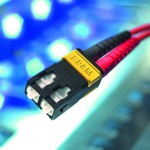
School districts should provide a minimum of 100 megabits per second (Mbps) of bandwidth for every 1,000 students and staff members within the next two years, and federal lawmakers should provide more funding to help make this happen, according to a report released May 21 by the State Educational Technology Directors Association (SETDA).
The report, “The Broadband Imperative: Recommendations to Address K-12 Education Infrastructure Needs,” explains how the ongoing shift to technology-rich learning has sparked rapid growth in the nation’s educational broadband needs.
Schools are undergoing a transformation from print-based to digital sources, and that shift “changes technology from being supplemental enrichment to something we rely on,” said Douglas Levin, executive director of SETDA at a report release and briefing in Washington, D.C.
To prepare students for college and careers, schools increasingly use internet-based tools for activities such as multimedia research and online testing. At a school with a technology-rich learning environment, students might use laptops in class to generate audio podcasts, work in e-textbooks, and collaborate with other students through wikis or video conferencing.
Young children entering school nowadays are accustomed to digital learning devices and expect that level of technology in schools, said Christine Fox, director of educational leadership and research at SEDTA.
“At one of our elementary schools, they Skype with their sister school in Taiwan. That’s what [the students] expect. They don’t realize how great the distance is between our schools. They realize how small the world is because of our technology,” said Andrew Zuckerman, director of instructional services for Lawrence Township, N.J., Public Schools.
Eventually, SETDA hopes to see broadband become ubiquitous in schools. With sufficient bandwidth, “technology then is no longer ‘nice to have,’ or ‘just for some,’ but an integral part of a school’s ecosystem. It’s systemic,” Fox said. “If, at the last minute, a teacher wants to participate in a conference across the country, the teacher with robust bandwidth access doesn’t have to ask, ‘Do we have bandwidth for that?’ They just do it.”
Recent research shows, however, that educational broadband needs are not currently being met. The report cites a 2010 survey by the Federal Communications Commission (FCC), which found that nearly 80 percent of responding schools reported their broadband connections to be inadequate for their needs.
To help policy makers and school leaders better implement broadband access into educational infrastructure, the new SETDA report makes four main recommendations:
- Move to address K-12 broadband infrastructure needs. SETDA recommends that at a minimum, schools and districts provide 100 Mbps per 1,000 students/staff by the 2014-15 school year, and provide 1 gigabit per second (Gbps) per 1,000 students/staff by the 2017-18 school year.
- Ensure broadband access for students and educators. Students should have broadband access not only within schools but also in the home and at public institutions such as libraries and community centers, Fox said.
- Build state leadership. “States are in a key place for leadership here to leverage with higher education, local telecommunications companies, and the federal government,” said Geoff Fletcher, deputy executive director of SETDA. Most states already have some sort of statewide network, so policy makers need to take a look at what their capacity is, and how they can work with other private and public entities to “piggyback off of each other,” Fletcher said.
- Advocate for federal funding. SETDA recommends increases in federal funding options to support maintaining statewide broadband networks, increasing bandwidth within districts, and improving connectivity in homes and public institutions. The e-Rate funding program strengthened by the 2010 FCC report, while helpful, struggles to meet an ever-increasing need.
For schools seeking to provide more broadband access, cost remains a primary concern.
“The e-Rate funding program is a $2.25 billion program with a demand curve of $5 million,” said Barbara Pryor of the office of Sen. John Rockefeller, D-W.Va. “Given the trend, that demand is not going to go down.”
In fact, despite nearly 15 years of e-Rate investments and another $7.5 billion in stimulus funding for national broadband initiatives, the nation’s schools still could face unprecedented need for more broadband funding.
“Not every district is in the same place [in terms of educational technology implementation]—there are speed boats, motor boats, tug boats, and even some rocks,” Fletcher said. “When all those folks get to where the speed boats are now, there’s going to be a tremendous need for increased funding.”
Some states and districts, however, have emerged as “lighthouses” that provide successful models of how to fund improved broadband networks successfully, Fletcher said.
Maine, for example, established a local version of e-Rate funding, called the Maine Telecommunications Education Access Fund (MTEAF). Between MTEAF and federal funding, Maine covers the cost of broadband access for all K-12 schools and libraries in the state.
“There’s no cost option,” said Jeff Mao, learning technology policy director for the Maine Department of Education. “During budget season, schools don’t have to factor in the cost of broadband.” In that way, Mao said, broadband becomes a given, and schools can focus on budgeting for other costs.
The report also points to other success stories, such as the Utah Education Network (UEN) that allows K-12 schools to connect to the internet via the high-capacity backbone of the state’s university system.
By presenting such real-world examples and offering concrete benchmarks, Mao said, the SETDA report “translates the geekspeak into human terms” that policy makers such as school board members and legislators can readily understand and thus implement.
Said Karen Cator, director of the Office of Educational Technology at the U.S. Department of Education: “This SETDA report takes us further than the National Broadband Plan by providing a specific goal by 2014—by putting a stake in the sand and saying, ‘Let’s go there.’”
- 7 reasons to ditch recipe-style science labs - November 22, 2024
- As a paradeducator, here’s how I use tech to help neurodivergent students gain agency - November 22, 2024
- 5 ways school districts can create successful community partnerships - November 21, 2024

